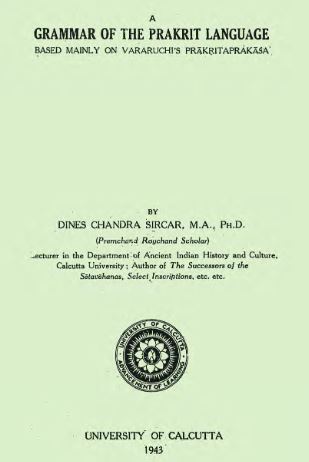Language, as an essential facet of culture, serves as a window into the soul of ancient civilizations. Understanding the linguistic heritage of a region not only illuminates its historical narrative but also enriches contemporary cultural identities. One monumental contribution to the field of linguistics, specifically in the study of Indian vernaculars, is Dines Chandra Sircar’s seminal work, “A Grammar of the Prakrit Language,” published in 1943.
Prakrit languages, a group of Middle Indo-Aryan languages, thrived alongside Sanskrit and contributed significantly to the literary, cultural, and religious landscape of ancient India. Prakrit is renowned for its role in early classical Indian dramas and Jain and Buddhist literature. Despite its historical significance, the complexities of its grammar and regional variations often pose a challenge to scholars and enthusiasts alike.
In his insightful book, Sircar meticulously dissects the Prakrit languages, offering a comprehensive analysis that remains impactful even today. The term ‘Prakrit’ itself incorporates a variety of related languages and dialects. Sircar’s work delves into their nuances, presenting a robust framework for understanding their distinct phonetic, morphological, and syntactical structures. By comparing Prakrit dialects with classical Sanskrit and examining their evolution, Sircar sheds light on the interconnectivity of India’s linguistic heritage.
The crux of Sircar’s book lies in its methodical approach to the grammar of Prakrit. Grammar forms the backbone of any language, providing rules and patterns that govern its proper use. Sircar’s “A Grammar of the Prakrit Language” stands as a testament to his scholarly precision, offering clarity on fundamental grammatical aspects such as phonology, morphology, and syntax.
Sircar unravels the intricacies of Prakrit phonetics, detailing the transformations from Sanskrit phonemes and outlining the diachronic phonological changes that influenced Prakrit’s development. This phonetic analysis is pivotal for linguists seeking to understand the sounds and their variations within these dialects.
Morphology, the study of word forms, is another key area explored in Sircar’s grammar. He methodically captures the inflectional paradigms of nouns, verbs, pronouns, and adjectives, showcasing how they differ from their Sanskrit counterparts. The verb conjugations and noun declensions are presented in an organized manner, facilitating an easier grasp of these complex structures.
Syntax, concerning sentence structure and word order, is also thoroughly examined. Sircar highlights the characteristic sentence constructions of the Prakrit languages, contrasting them with Sanskrit to underline their unique grammatical rules.
Discussing Sircar’s work ultimately converges on its monumental academic and cultural value. Academically, it serves as an essential resource for linguists, historians, and philologists studying ancient Indian languages. Its comprehensive and detailed treatment of Prakrit provides a foundational reference for subsequent research
Culturally, understanding the Prakrit languages through Sircar’s lens offers invaluable insights into the societal and literary richness of ancient India. This linguistic competence opens up access to a vast corpus of Prakrit literature, including Jain scriptures and classical dramas, fostering a deeper appreciation for India’s historical and cultural legacy.
“A Grammar of the Prakrit Language” by Dines Chandra Sircar stands as a profound scholarly work that bridges gaps in our understanding of ancient Indian linguistics. Published in 1943, it continues to illuminate the path for scholars and enthusiasts exploring the rich tapestry of India’s linguistic history. Sircar’s meticulous approach to Prakrit grammar not only enhances our academic resources but also nurtures our cultural consciousness, celebrating the enduring legacy of India’s diverse linguistic heritage.
Books Info
| Books name | A Grammar Of The Prakrit Language |
| Editor | Dines Chandra Sircar |
| No Of pages | 137 |
| Publisher | Sri Padeepa Kumar Hota |
| Publication | 1943 |
| Printed At | Magnem Printers |
| Distributor | NA |

